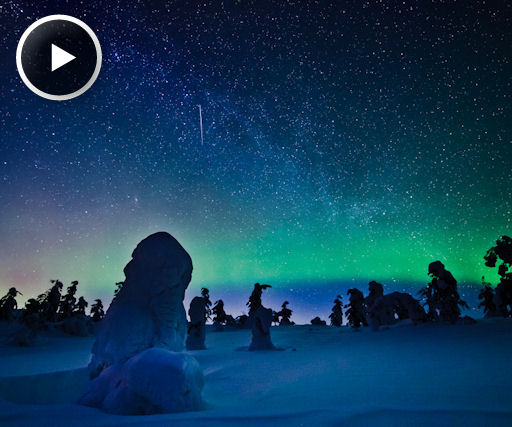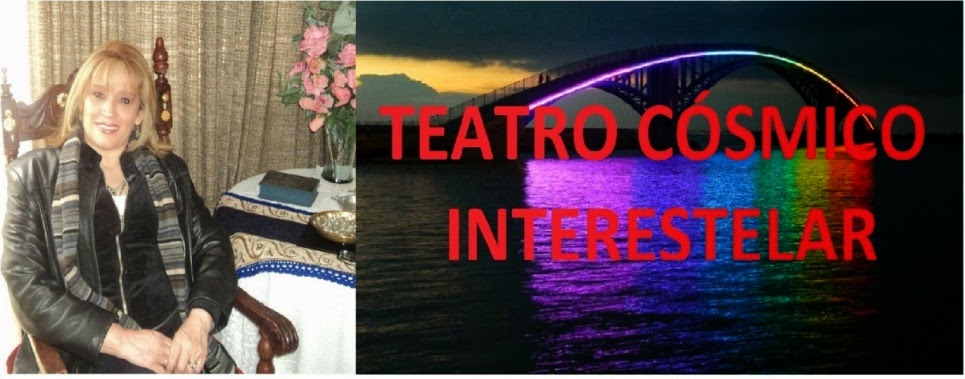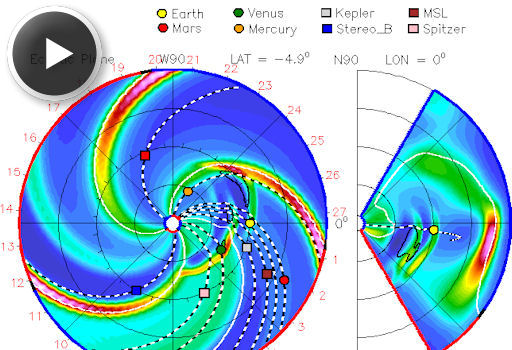|
Listen to radar echoes from satellites and meteors, live on listener-supported Space Weather Radio. |
|
|
LYRID
METEOR SHOWER: The annual Lyrid
meteor shower peaks this weekend on the night of
April 21-22 when Earth passes through a stream of
debris from ancient Comet Thatcher. Usually the
shower is mild (10-20 meteors per hour) but unmapped
filaments of dust in the comet's tail sometimes
trigger outbursts ten times stronger. This year's
peak coincides with a new Moon, which has prompted
NASA to attempt an unusual 3D meteor photography
experiment. Browse the links for more information:
observing
tips, meteor
radar, NASA
chat, 3D
meteors, Lyrid
video.
RUBBER
CHICKEN FLIES INTO SOLAR STORM:
In a unusual twist on space science, students
in California have launched a rubber chicken to
the edge of space to study a solar storm. Get the
full
story from Science@NASA.
INCOMING
PLASMA CLOUDS: On April 18th and
19th, a series of minor CMEs puffed away from the
sun. Three of them are heading in our general direction.
Analysts at the Goddard Space Weather Lab have prepared
an animated forecast track of the ensemble:
According to the forecast, the clouds
are going to hit Mercury, Earth, Mars and rover
Curiosity en route to Mars. The impact on our
planet, on April 22nd around 00:50 UT, is expected
to be minor with auroras likely only at higher latitudes.
Aurora alerts:
text,
voice.
ARCTIC
AURORA RECAP: As the midnight sun
returns to the Arctic, northern sky watchers are
looking back on the 2011-2012 aurora season with
pleasure. "There has definitely been increased
activity this season as the solar cycle heads toward
a maximum in 2013," says photographer Ole C.
Salomonsen. "To commemorate the season I have
assembled a video from photos I took in northern
parts of Norway, Finland and Sweden from fall 2011
to spring 2012." Click to play:
 . .
"This video marks the end of
a very exciting aurora season for me," says
Salomonsen. "It has made me very excited for
the upcoming season (autumn 2012), and what it has
to offer in terms of celestial lights and experiences!"
This doesn't mean that auroras are
gone for everyone. The Arctic Circle may be brightening
with summer sunlight, but lower latitudes still
have enough darkness for Northern Lights. Indeed,
upper-middle latitude sky watchers should be alert
for auroras on April 20th. NOAA forcasters estimate
a 35% chance of geomagnetic activity as Earth enters
a region of negative polarity IMF.
Potentially Hazardous Asteroids (PHAs)
are space rocks larger than approximately 100m that
can come closer to Earth than 0.05 AU. None of the
known PHAs is on a collision course with our planet,
although astronomers are finding new
ones all the time.
On
April 21, 2012 there were 1287
potentially hazardous asteroids.
Notes: LD means
"Lunar Distance." 1 LD = 384,401 km, the distance
between Earth and the Moon. 1 LD also equals 0.00256
AU. MAG is the visual magnitude of the asteroid on
the date of closest approach.
| |
The
official U.S. government space weather bureau |
| |
The
first place to look for information about sundogs,
pillars, rainbows and related phenomena. |
| |
Researchers
call it a "Hubble for the sun." SDO
is the most advanced solar observatory ever. |
| |
3D
views of the sun from NASA's Solar and Terrestrial
Relations Observatory |
| |
Realtime
and archival images of the Sun from SOHO. |
| |
from
the NOAA Space Environment Center |
| |
the
underlying science of space weather |
| 



No hay comentarios:
Publicar un comentario